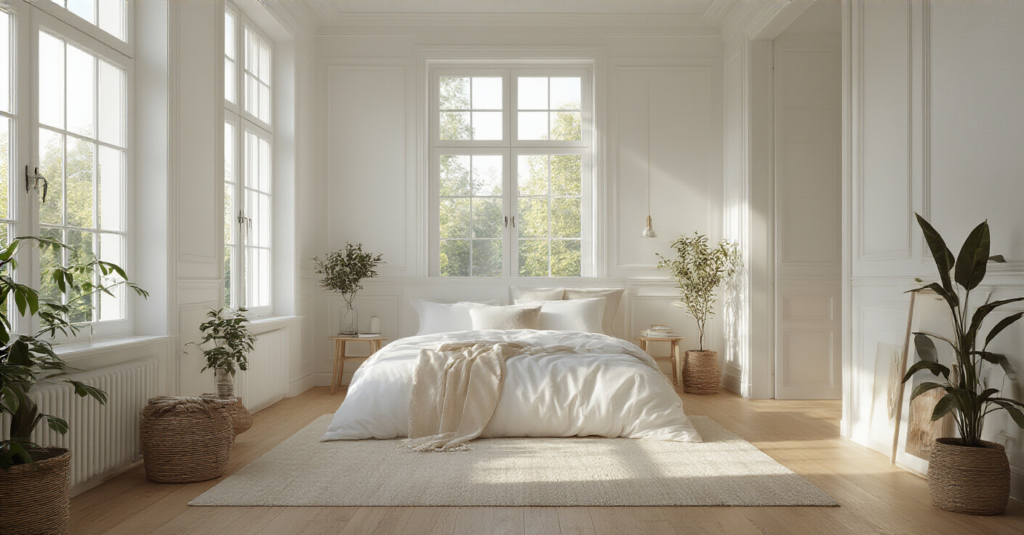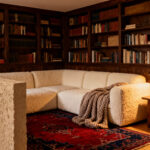You know what drives me absolutely nuts? When people say a white bedroom is “easy.” They think you just slap a coat of generic landlord-white on the walls, throw in a white duvet, and you’re done. What you actually end up with is a sterile, boring box that feels more like a hospital room than a sanctuary. It’s cold, it’s flat, and it has all the personality of a blank sheet of paper.
A truly great white bedroom isn’t about the absence of color. It’s a highly intentional system designed for calm. It’s about mastering light, texture, and form to create a space that’s visually quiet, letting your mind relax the second you walk in. It’s an organizer’s dream, because when you lower the visual noise, you create a foundation for a life that feels less chaotic. So, let’s talk about how to do it right. Forget the generic advice—this is the real system for creating a white bedroom that feels luxurious, personal, and deeply restorative.
The Canvas: Setting the White Foundation
Before we get to the fun stuff like pillows and art, we have to build the container. This is the most important part. Think of it like building custom cabinetry: the box has to be square and strong before you can even think about the beautiful doors. Getting these foundational elements—the walls, the floor, the main furniture—right is the difference between a chic retreat and a sad, empty room.
1. Choose the Right White Paint Shade for Optimal Brightness
People always ask me, “Quincy, what’s the best white paint?” There is no single answer, and that’s the entire point. The biggest mistake people make is grabbing a can of “pure white” without understanding their room’s light. White isn’t one color; it’s a spectrum of undertones. A north-facing room gets cool, blueish light all day. If you put a cool-toned, stark white in there, you’ve just created an ice cave. That room is crying out for a white with a creamy or warm greige undertone to feel cozy. A super sunny, south-facing room, on the other hand, can handle a crisper, cooler white to balance out all that yellow light.
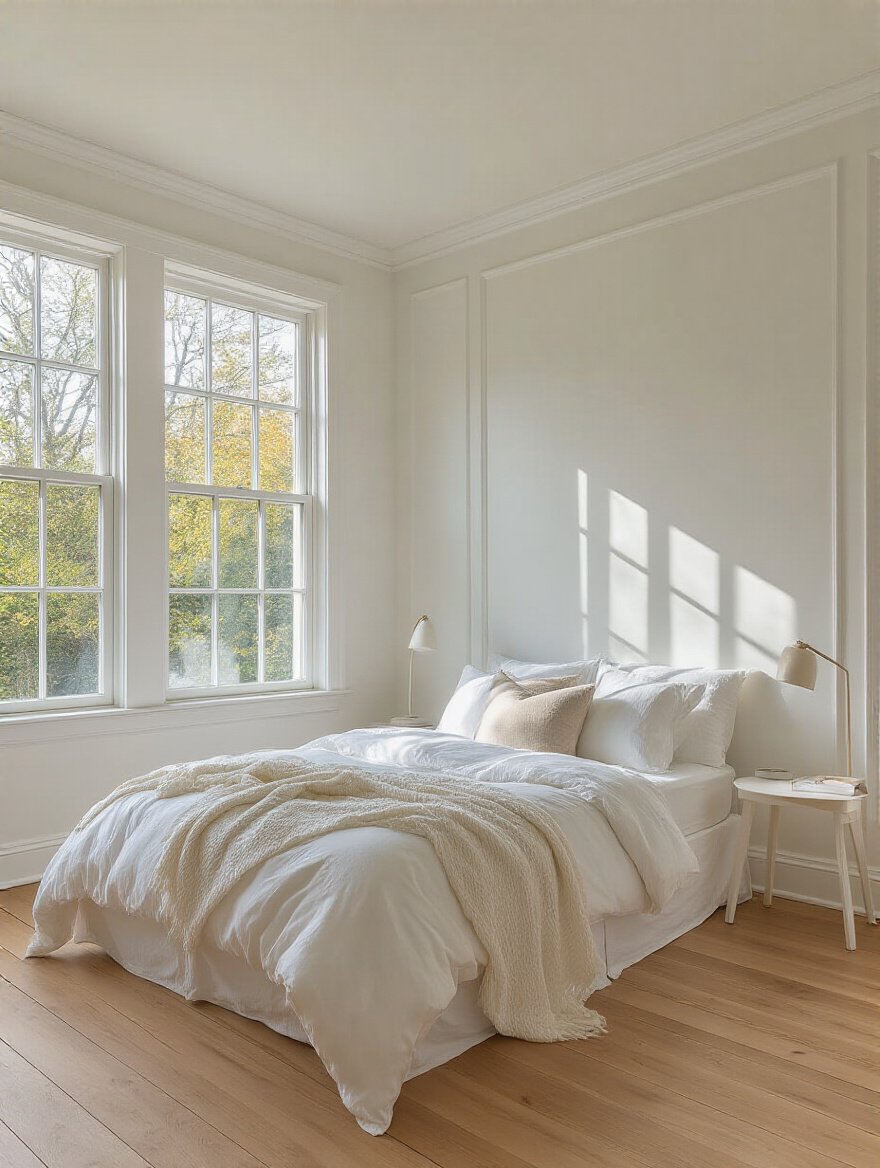
The noise you can ignore is all the complex talk about Light Reflectance Value (LRV). Yes, it matters, but you don’t need a physics degree. Here’s the shortcut I wish I’d known earlier: Go buy large, peel-and-stick paint samples of three different whites—one you think is perfect, one that’s a little warmer, and one that’s a little cooler. Stick them on the main wall and look at them in the morning, at noon, and at night with the lamps on. The tiny paint chip lies. Your room’s light will tell you which one is right. That’s the only test that matters.
With our walls set, we need to think about the large-scale objects that will live against them.
2. Select Crisp White Furniture for a Seamless Foundation
Here’s the thing about furniture: dark pieces create contrast. A dark wood Bed Frame in a white room says, “Look at me! I am the bed!” It’s a focal point. But crisp white furniture does the opposite. It creates a low-contrast, seamless backdrop. It essentially “disappears” into the walls, tricking your brain into seeing less visual clutter. This is a core principle of organization—reducing visual noise allows your mind to rest. It’s the secret to making a small room feel bigger and a busy room feel calmer.
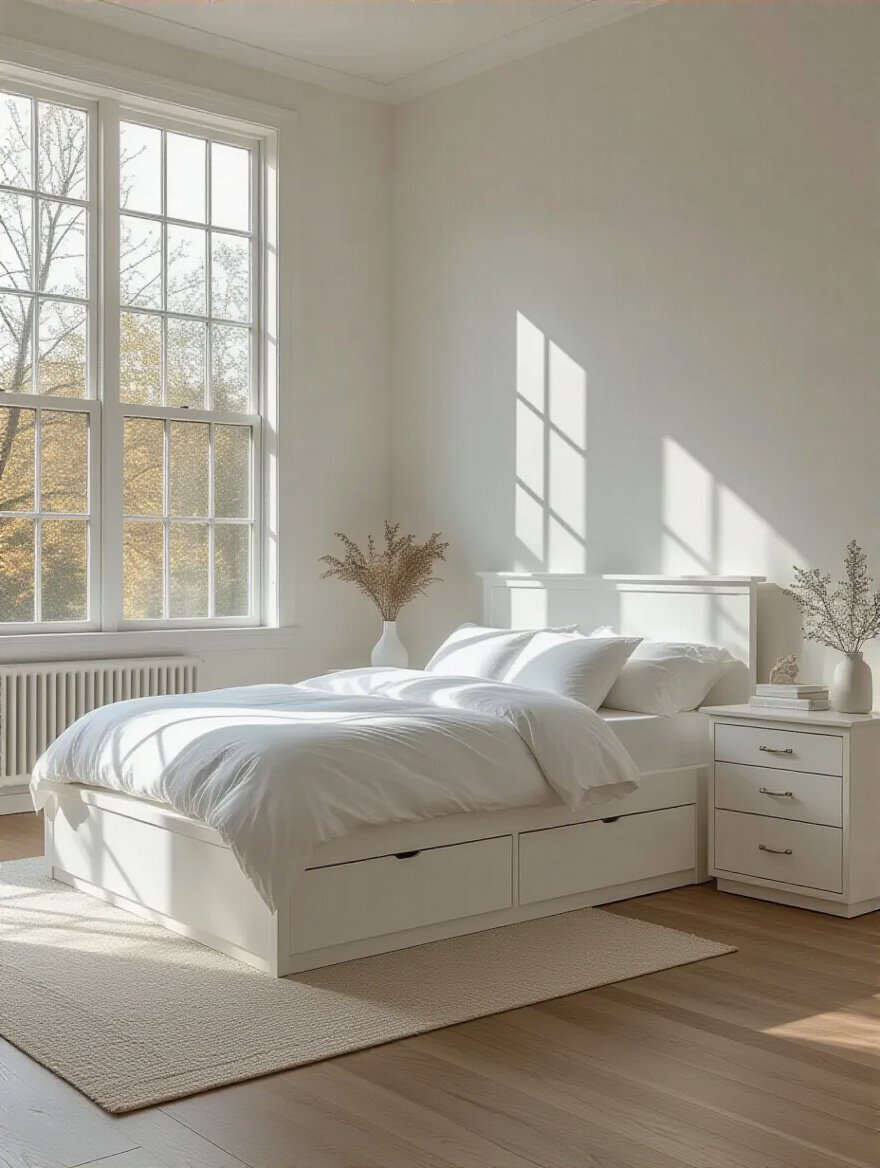
I learned this the hard way with a client who had a small bedroom packed with gorgeous, but mismatched, dark wood antiques. It felt suffocating. We swapped them for streamlined white pieces—a platform bed, a simple dresser, floating nightstands—and the room instantly felt twice as large and a hundred times more peaceful. The key is to choose white furniture that either matches your wall’s undertone or is a true, neutral white. Avoid mixing a creamy off-white dresser with a stark, blue-white bed frame unless you’re a design pro who knows exactly how to pull it off. Otherwise, it just looks like you bought things at different times without a plan.
Now let’s look down. The surface under our feet is a massive part of the visual plane.
3. Install Light-Toned Flooring to Expand Your Space Visually
You want to know the ultimate trick for making a space feel bigger? Create a continuous visual line. When you have light-colored flooring that’s similar in tone to your white walls, your eye doesn’t stop at the baseboard. The transition between the floor and the wall becomes almost invisible, so your brain reads the entire space as one larger, unified whole. Dark floors do the opposite; they create a hard, visual stop line that chops up the space.
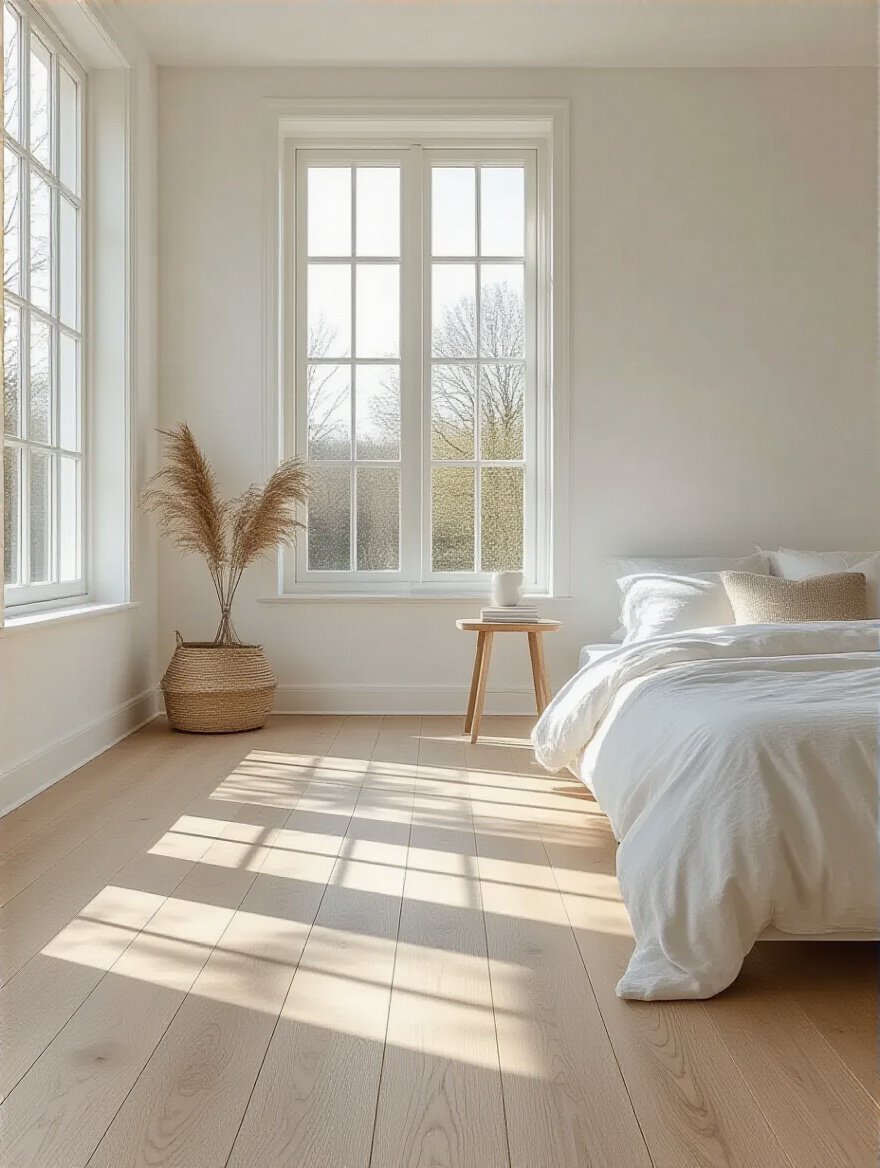
This is especially crucial in smaller homes or apartments. I once worked on a downsizing project where the client was moving from a big house into a condo. She was worried her bedroom would feel cramped. The first thing we did was rip out the dated, dark carpet and install pale, wide-plank white oak flooring. We carried that same flooring out from the bedroom and into the hallway. The effect was immediate and dramatic. It created an uninterrupted flow that made her entire living space feel more cohesive and expansive. The takeaway here is to think of your floor and walls as a single shell. The more seamless that shell is, the more serene the space will feel.
With the basic surfaces handled, we need to address the number one enemy of serenity: clutter.
4. Incorporate Built-In White Storage to Minimize Clutter
Okay, this is where my cabinetry background comes in, and this is non-negotiable for a truly high-functioning white bedroom. Freestanding furniture—even if it’s white—adds visual clutter. It’s another thing in the room. Built-in storage that is painted the exact same color as the walls, on the other hand, disappears. It becomes part of the architecture. It’s the ultimate storage hack because you can add a massive amount of organization without adding any visual weight.
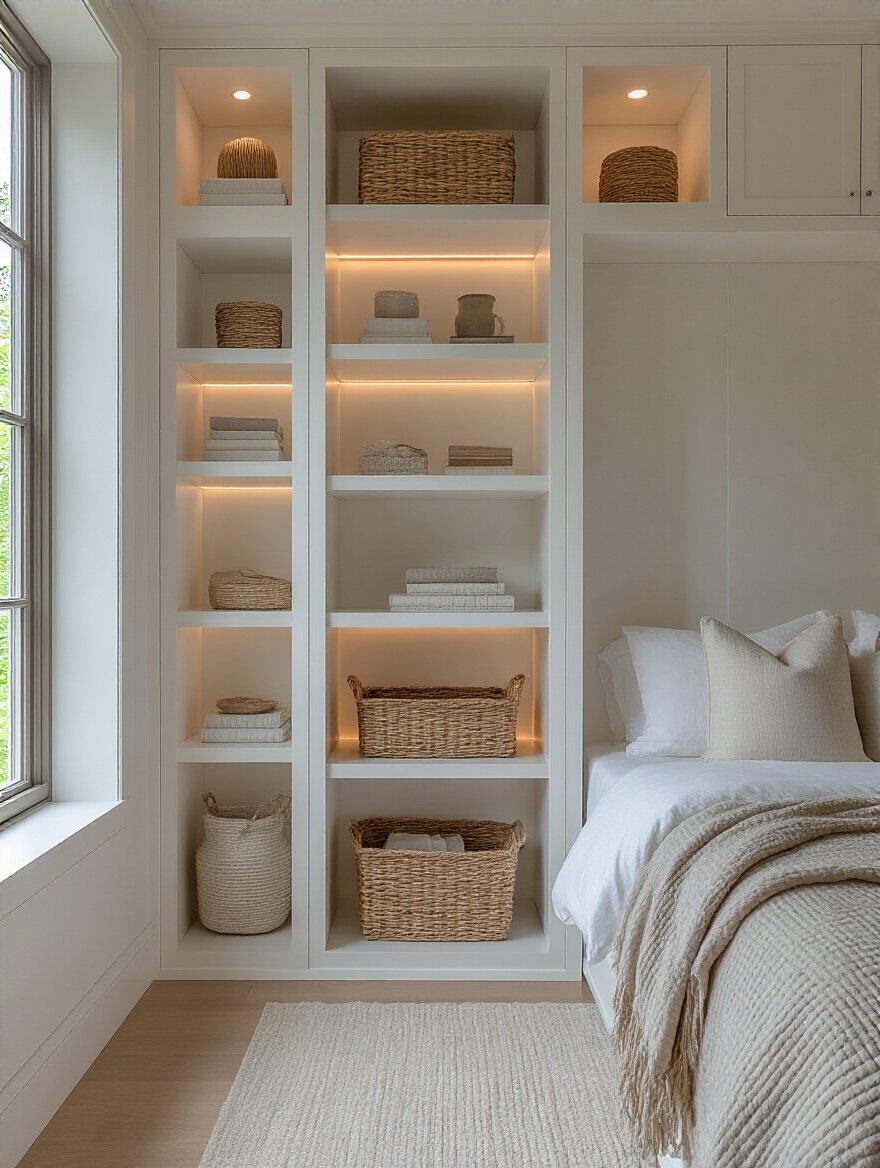
I had a client whose bedroom was a battlefield of “stuff.” Clothes overflowing from a dresser, books piled on the nightstand, extra blankets in a basket. We designed a floor-to-ceiling, wall-to-wall built-in unit around her bed. It had closets flanking the headboard, integrated nightstands, and deep drawers below. When it was painted the same soft white as her walls (Benjamin Moore’s Chantilly Lace, if you’re curious), it was like magic. All the clutter vanished into a calm, seamless wall, and the room felt bigger and more custom. Here’s the shortcut: Go all the way to the ceiling. It draws the eye up and eliminates that dusty, useless gap on top of a wardrobe where things go to die.
Now that everything has a home, let’s talk about managing the most powerful element in a white room: light.
5. Opt for Sheer White Window Treatments for Natural Light
White walls are basically giant light reflectors. If you have direct, harsh sunlight blasting in, a white room can feel blinding and unpleasant. The goal isn’t just more light, it’s better quality light. Sheer white curtains are the answer. They act as a diffuser, taking that harsh, direct sun and softening it into a gentle, ambient glow that bathes the entire room. It’s like putting a soft-focus filter on your space.
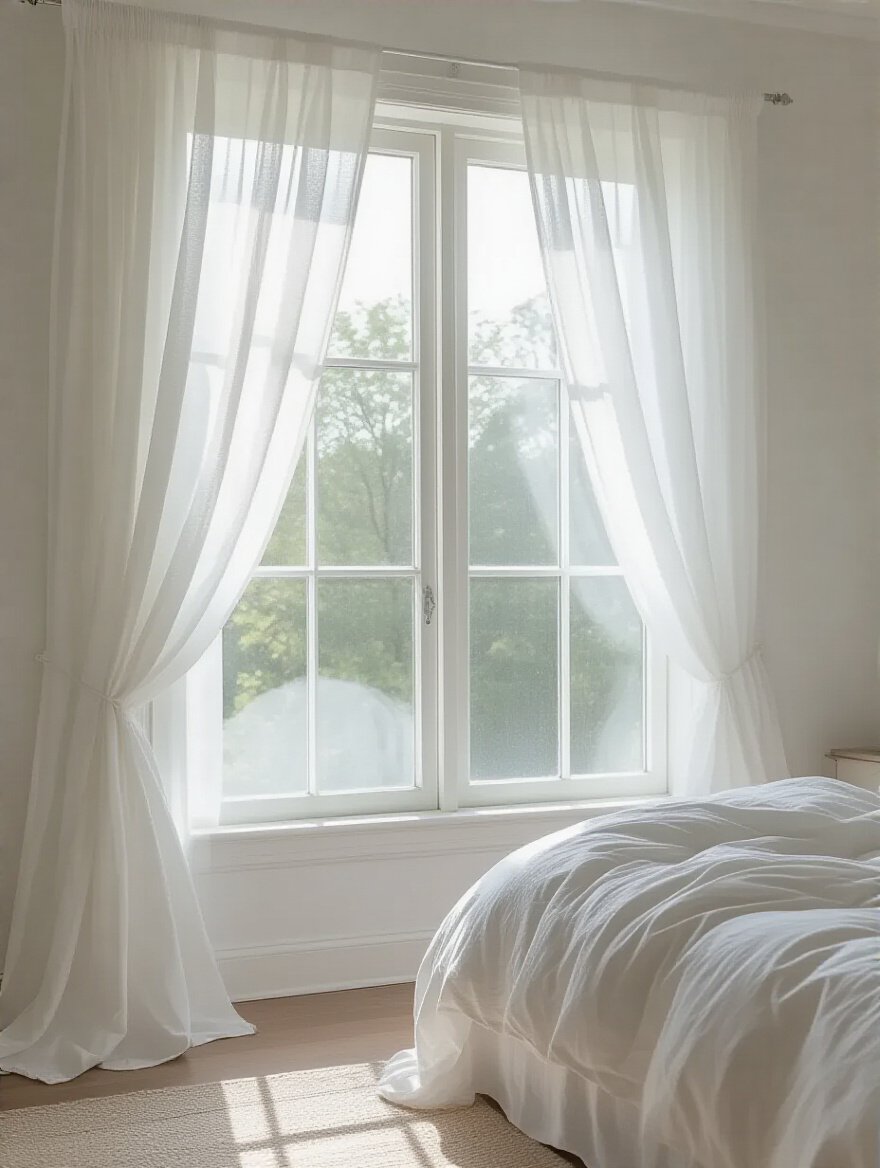
The rookie mistake is buying curtains that are the exact width of the window. It looks cheap and skimpy. The pro move is to get panels that are at least twice the width of your window, so they look full and luxurious even when closed. And hang the rod high and wide—at least 4-6 inches above the window frame and 6-12 inches past it on either side. This makes your window look much bigger and allows the curtains to be pulled completely clear of the glass, maximizing light when you want it. For true functionality, use a double rod system: sheers on the inside for that beautiful daytime glow, and blackout curtains on the outside for privacy and sleeping in.
Textural Nuances: Layering White-on-White Depth
This is the part that separates the amateurs from the pros. Once your foundation is set, a white room can still fall flat. The secret to making it feel rich, cozy, and intentional is texture. In a monochromatic space, texture does the work that color normally would. It’s what you see with your eye and feel with your hand that creates depth and interest.
6. Combine Varying White Fabric Textures for Visual Interest
If you only take one piece of advice from this section, make it this one. A bed with a flat white cotton duvet, flat white cotton pillows, and a flat white cotton blanket is the definition of boring. It’s a white rectangle. To bring it to life, you need to layer textures like you’re making a lasagna. Start with your smooth sateen or crisp percale sheets. Then add a linen duvet cover, which has a beautiful, natural rumple to it. Then, layer on the pillows: maybe a chunky white knit pillow, a soft faux-fur one, and one made of nubby, textural bouclé.

Each of these materials catches the light differently. The knit creates deep shadows, the linen has subtle creases, and the fur has a soft sheen. This combination of textures is what makes the bed look inviting and luxurious, not sterile.
“Without texture, a monochromatic room has no soul. It’s just a blank slate. Texture is what gives it a story and makes it feel like a home.”
Your goal should be at least three distinct textures on the bed alone. It’s a simple rule that makes a world of difference.
From the bed, let’s ground the entire zone with a single, powerful statement underfoot.
7. Introduce a Plush White Rug to Anchor the Bed Area
A plush, high-pile white rug is like a warm hug for your bedroom. It does three crucial things. First, it adds a huge dose of luxurious texture and softness, which is especially important if you have hardwood or tile floors. Waking up and stepping onto a soft, warm surface instead of a cold, hard one is a small daily upgrade that makes a big difference. Second, it absorbs sound, making the room quieter and more peaceful.
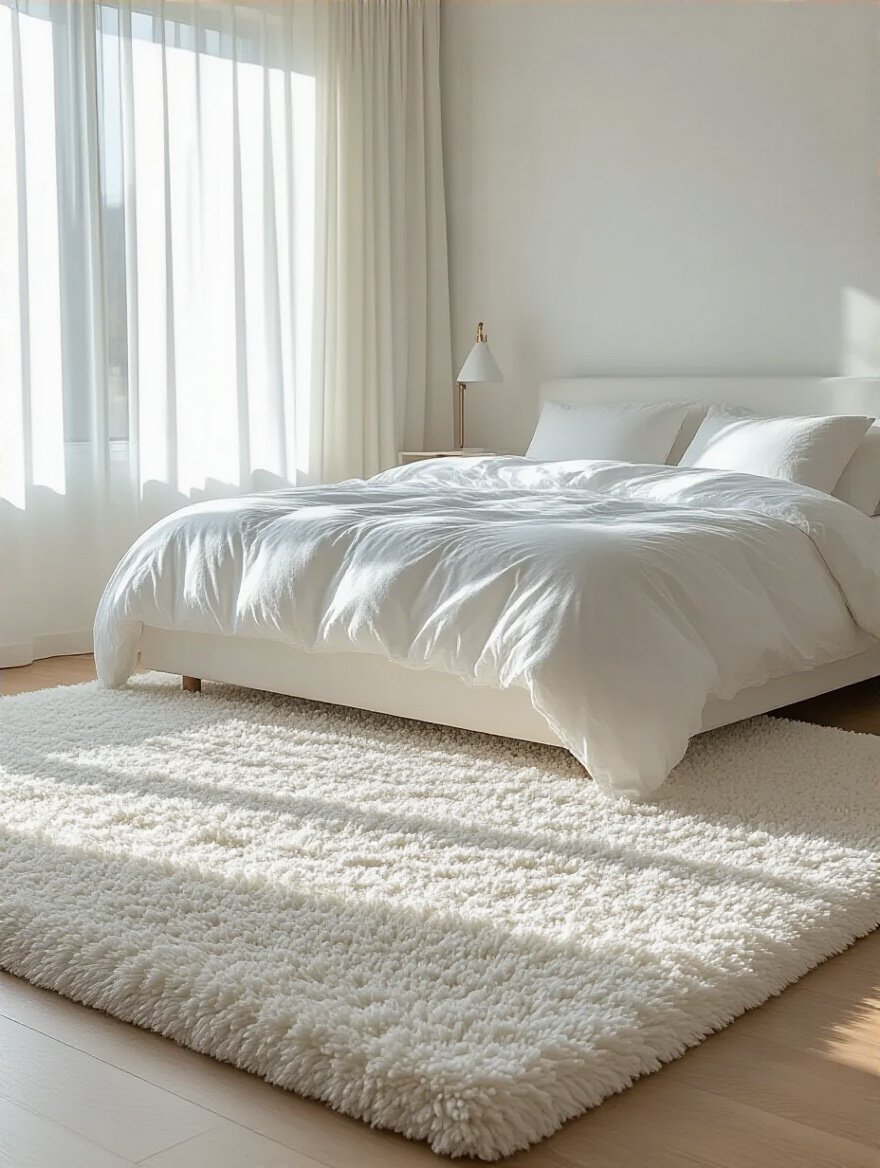
But most importantly from a design perspective, it anchors the bed area. It defines the “sleep zone” and makes the room’s layout feel more intentional. The biggest mistake people make here is buying a rug that’s too small. You know the ones—they look like a sad little postage stamp floating at the foot of the bed. For a queen bed, you want a rug that’s at least 8×10 feet. The proper way to place it is so that the rug extends at least 18-24 inches beyond the sides and foot of the bed. This makes the whole setup feel grand and well-proportioned, not skimpy.
Let’s carry that feeling of soft texture up to the windows.
8. Drape White Linen Curtains for Soft, Ethereal Ambiance
We talked about sheer curtains for light diffusion, but the material choice matters. White linen curtains are the gold standard for a reason. Polyester sheers can look a bit cheap and shiny. Linen, with its natural slubs and organic texture, has an inherent sophistication and a relaxed, effortless quality. It drapes beautifully and adds a layer of soft, tactile interest to the walls without adding any visual clutter.
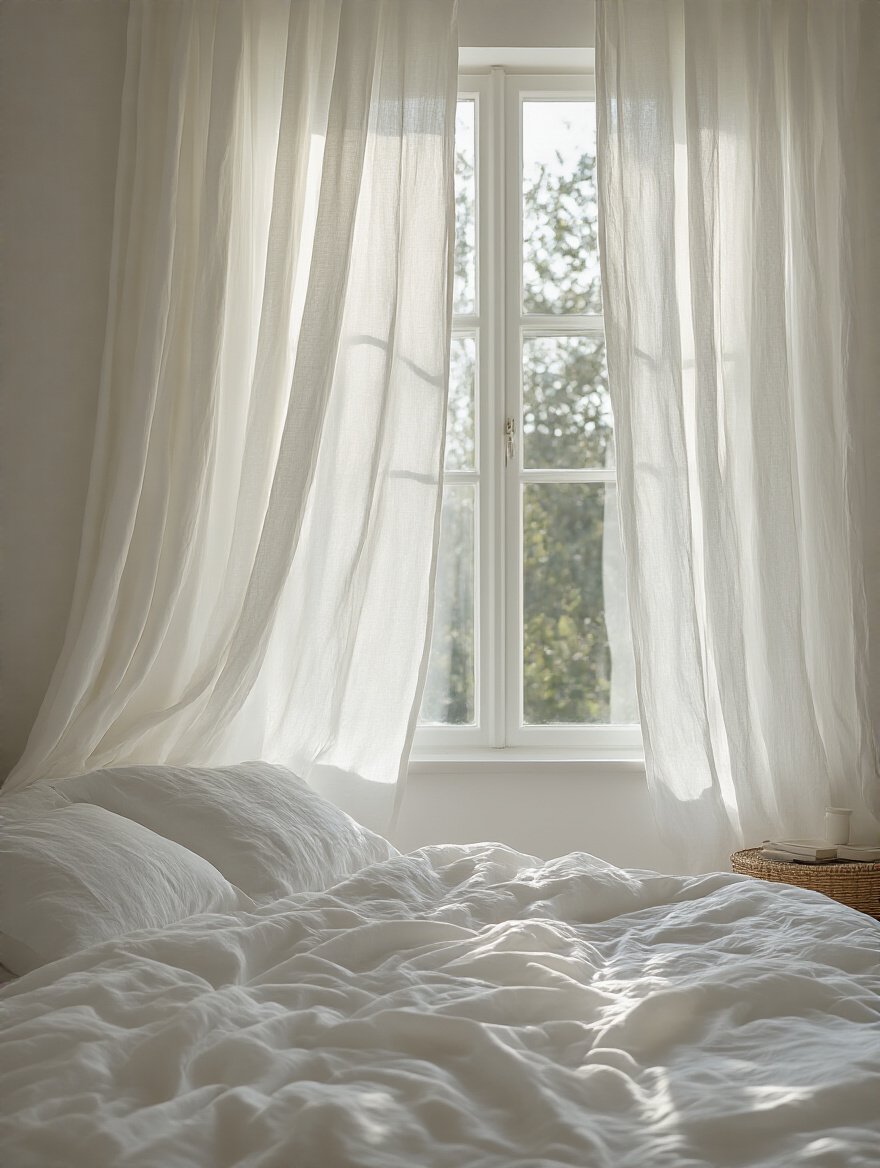
The trick to making them look truly ethereal and high-end is to let them “kiss” the floor. They should just graze the surface or have a slight 1-2 inch break. Curtains that are too short—the dreaded “high-waters”—visually shrink the room and look like a mistake. Getting the length right is a small detail that has an outsized impact on the overall polish of the space, making it feel custom-designed.
Now, let’s add some of that texture and interest directly to the walls themselves.
9. Feature White Wood Paneling for Architectural Detail
If your white room is feeling a bit like a featureless box, adding architectural detail is the answer. Paneling like shiplap, beadboard, or classic board and batten is a brilliant way to add depth and character without adding color. The seams and grooves create subtle shadow lines that change throughout the day as the light moves across the room. It’s a dynamic effect that makes a plain wall incredibly interesting.
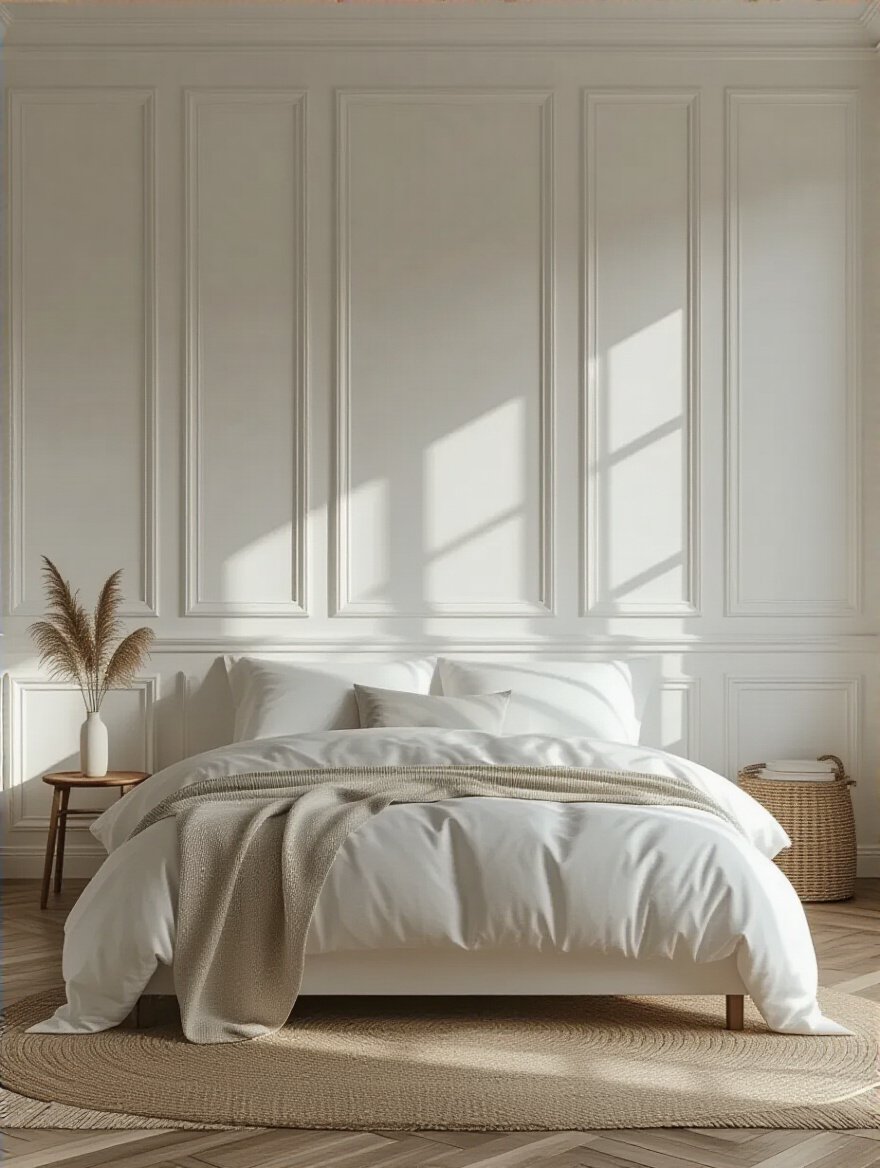
My favorite application is to create an accent wall behind the bed. It instantly creates a focal point and makes the entire room feel more grounded and expensive. And here’s a pro tip: paint the paneling a slightly different sheen than the rest of the walls. For instance, if your walls are a matte or eggshell finish, use a satin finish on the paneling. This subtle shift in reflectivity makes the architectural detail pop just a little bit more, adding a layer of sophisticated, custom-designed detail.
Even the smallest objects can play a role in this layering game.
10. Stack White Books and Decor for Subtle Layering
This is a stylist’s secret for adding depth to a surface like a nightstand or dresser. Instead of just placing a lamp and a clock on the table, you create little vignettes. Gather a few books with white, cream, or light neutral spines and stack them horizontally. This stack then becomes a pedestal for a small decorative object—like a little ceramic bowl or a small piece of coral. It’s all about creating layers of height and texture.
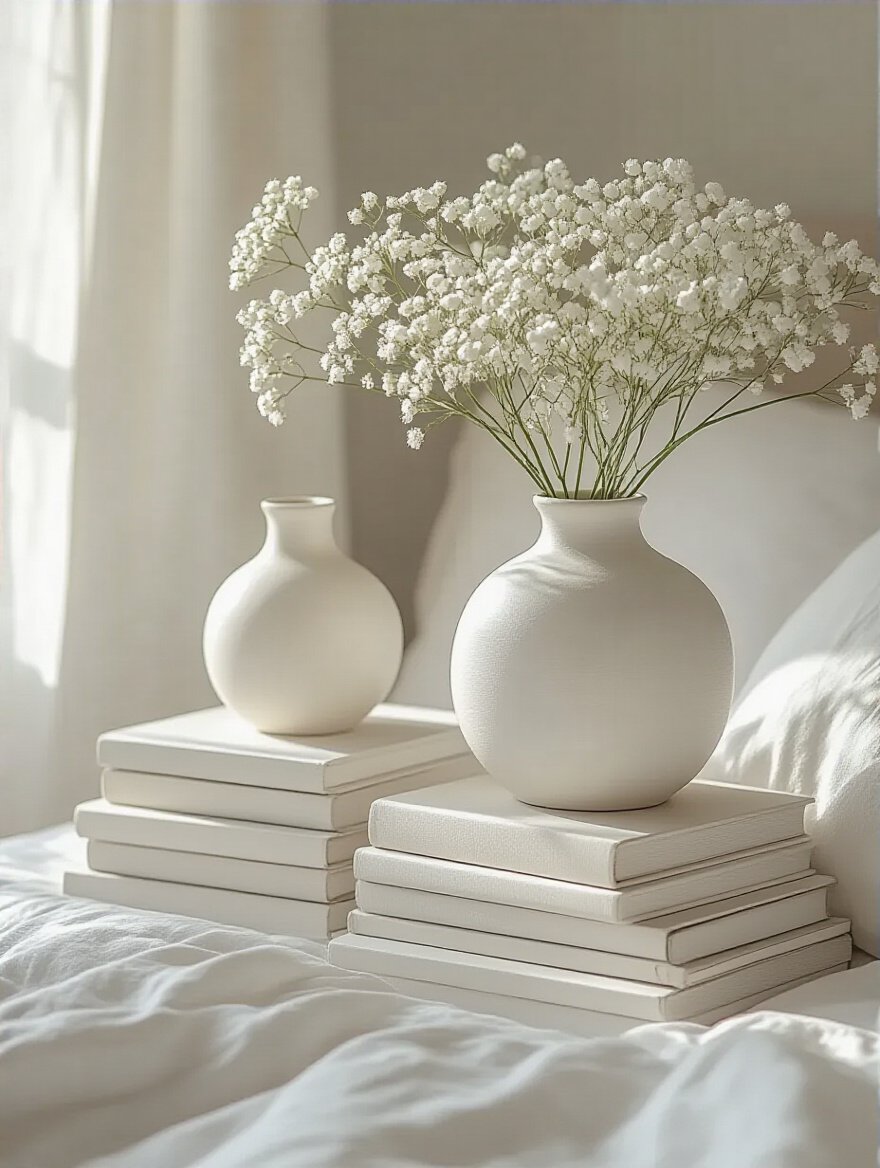
Don’t get hung up on finding books with perfectly white spines. Honestly, turning books around so the pages face out is a silly trend that makes your books unusable. A mix of neutral spines in shades of cream, beige, and light gray adds more realistic and interesting depth. The key is to curate, not just accumulate. A thoughtful stack of three books with a small object on top looks intentional. A messy pile of ten looks like clutter.
Let’s expand on that idea of using objects as art.
11. Utilize White Ceramics and Vases for Sculptural Forms
When you take color out of the equation, you start to notice other things—specifically, shape and form. A collection of white ceramic vases or pottery becomes less about what they hold and more about their silhouettes. They are essentially small sculptures. Look for pieces with interesting shapes: a tall, slender vase, a round, chubby pot, and a low, irregular bowl. Grouping them together creates a beautiful interplay of forms.
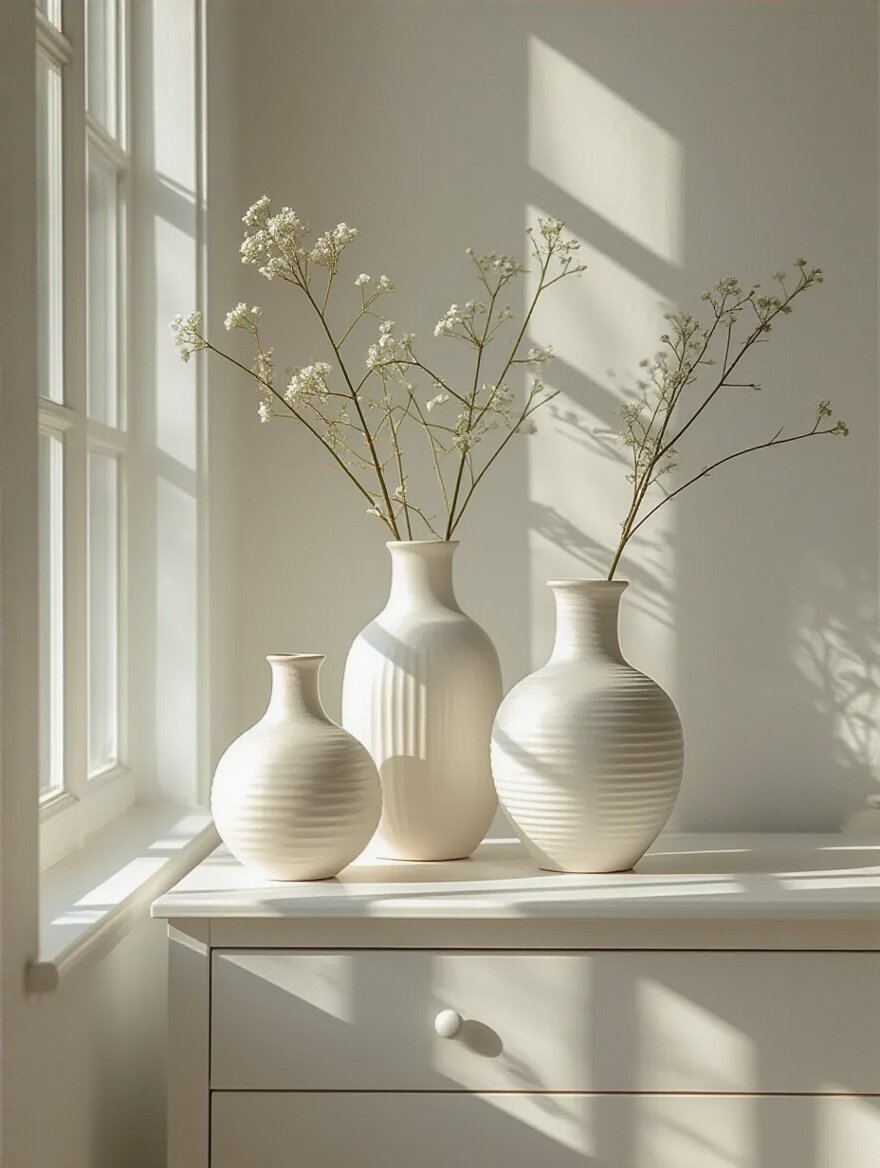
To make them really stand out, give them breathing room. Place a small grouping on a dresser or a shelf, but leave plenty of negative space around them. This highlights their sculptural quality and makes them feel like curated art. A great place to find unique pieces is at local art fairs or on Etsy, where you can find handmade items with texture—ribbed, matte, or unglazed finishes all add to that tactile richness we’re building.
Strategic Accents: Infusing Life and Warmth
Okay, our white room has a solid foundation and beautiful texture. Now it’s time to add the final 10%—the strategic accents that bring in warmth, personality, and a spark of life. This is the “jewelry” of the room. It’s what keeps the space from feeling one-note and makes it feel uniquely yours.
12. Introduce Warm Metallic Accents for Elegant Contrast
An all-white room can sometimes lean a little cool or clinical. The fastest way to combat this is with a touch of warm metal. Think brushed brass, soft gold, or aged copper. These metals act like little sunbeams, bouncing warm light around the room and adding a touch of instant luxury. It’s the difference between a simple outfit and one that looks styled—it’s all in the accessories.
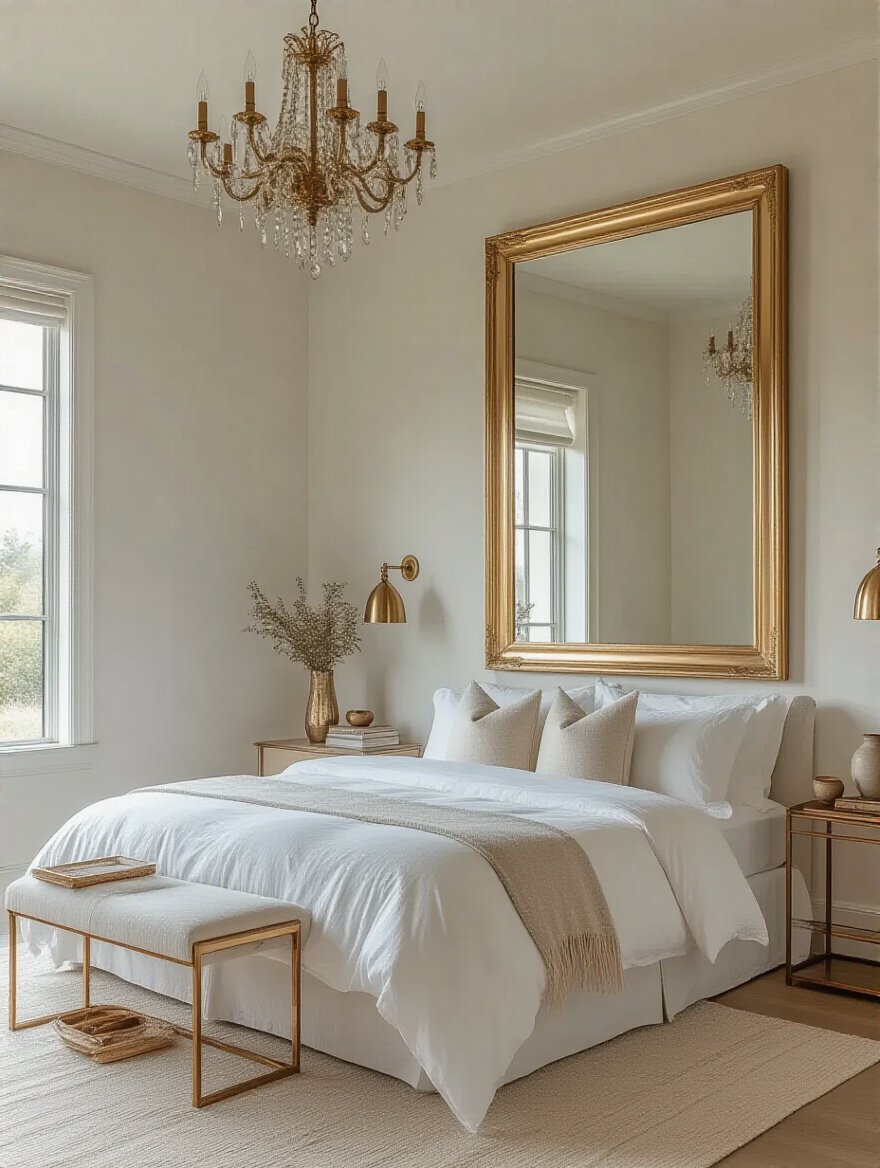
The key is consistency and restraint. Pick one primary metal—say, brushed brass—and sprinkle it around the room in at least three places to make it feel intentional. This could be the legs of a nightstand, the frame of a mirror, and the base of a table lamp. This creates a cohesive “story” that ties the room together. A common mistake is going overboard. A few thoughtful touches are elegant; too many and it starts to look gaudy. Balance the sparkle of the metal with the softness of your fabrics.
From man-made shine, let’s bring in a touch of natural life.
13. Place Strategic Greenery for a Pop of Natural Vibrancy
Every beautifully designed white room I’ve ever seen has one thing in common: at least one plant. A living, green plant is the perfect antidote to a space that feels too sterile or static. It brings in an organic shape, a natural texture, and a pop of vibrant color that feels energizing and fresh. It literally breathes life into the room.
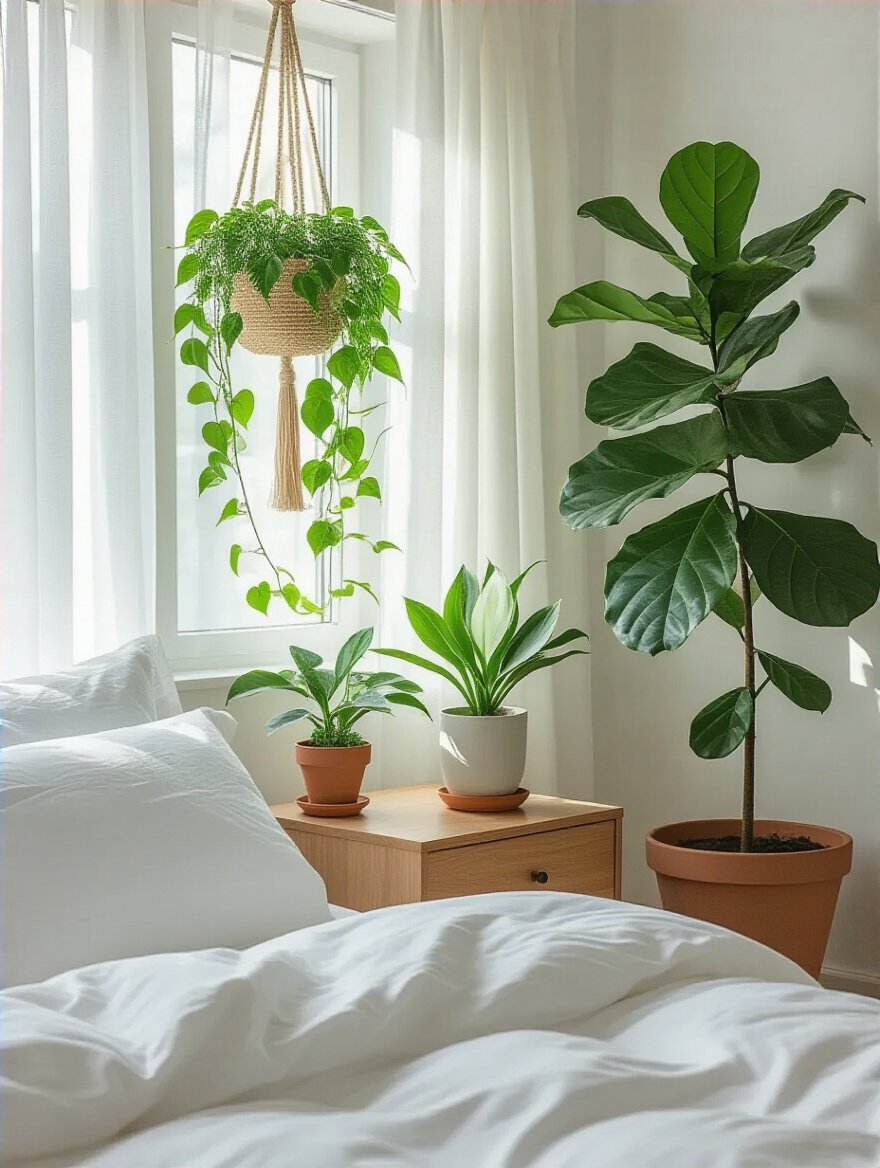
The trick is to be strategic. You don’t need a whole jungle. One tall, sculptural plant in a corner, like a Fiddle Leaf Fig or a Bird of Paradise, can be a stunning focal point. Then maybe add a small trailing plant, like a Pothos, on a high shelf. And choose your planter wisely! A simple terracotta pot, a woven basket, or a sleek white ceramic planter will keep the focus on the plant and integrate seamlessly into your calm aesthetic. It’s the easiest way to add a layer of natural beauty.
Now let’s talk about adding softness through very subtle color.
14. Add Soft Neutral Pillows for Subtle Color Definition
If you’re a bit scared of going all-in on pure white, this is your entry point. Introducing soft, muted neutrals like oatmeal, pale taupe, mushroom grey, or the faintest blush pink through your decorative pillows is a fantastic way to add warmth and definition without breaking the serene vibe. These tones are still very quiet and calming, but they provide just enough contrast against the crisp white bedding to create depth.
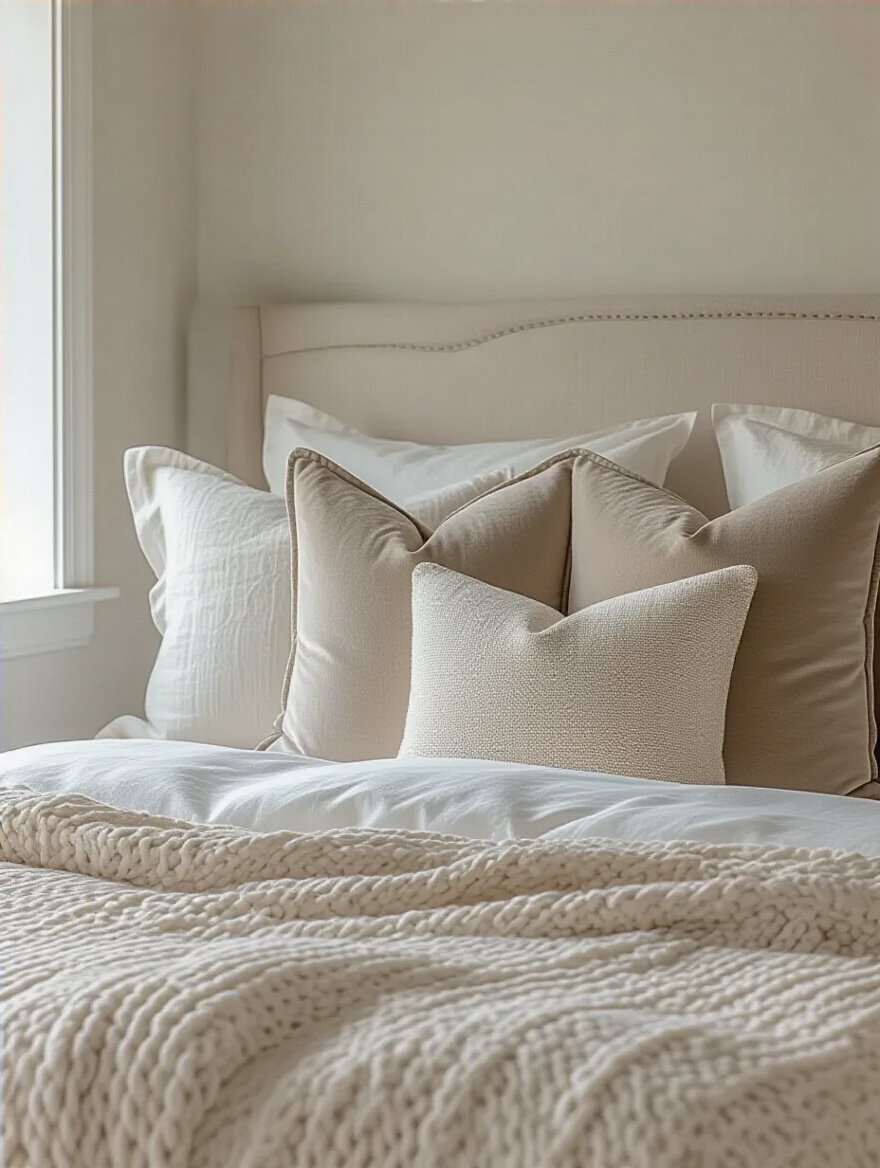
This is another opportunity to play with texture. Look for a pale taupe pillow in a slubby linen, a blush pillow in plush velvet, or an oatmeal pillow in a cozy cashmere knit. The combination of the subtle, earthy color and the rich texture makes the bed look incredibly sophisticated and inviting. The rule of thumb is to stick to a tight palette of 2-3 complementary neutrals to keep the look cohesive and curated, not random.
Let’s ground all this softness with a more solid, organic element.
15. Integrate Natural Wood Tones for Earthy Warmth
Alongside plants, natural wood is the best way to keep a white room from feeling cold. The warm tones and organic grain of wood provide a much-needed earthy element that grounds the entire space. It adds a sense of history and permanence that beautifully balances the airiness of the white.
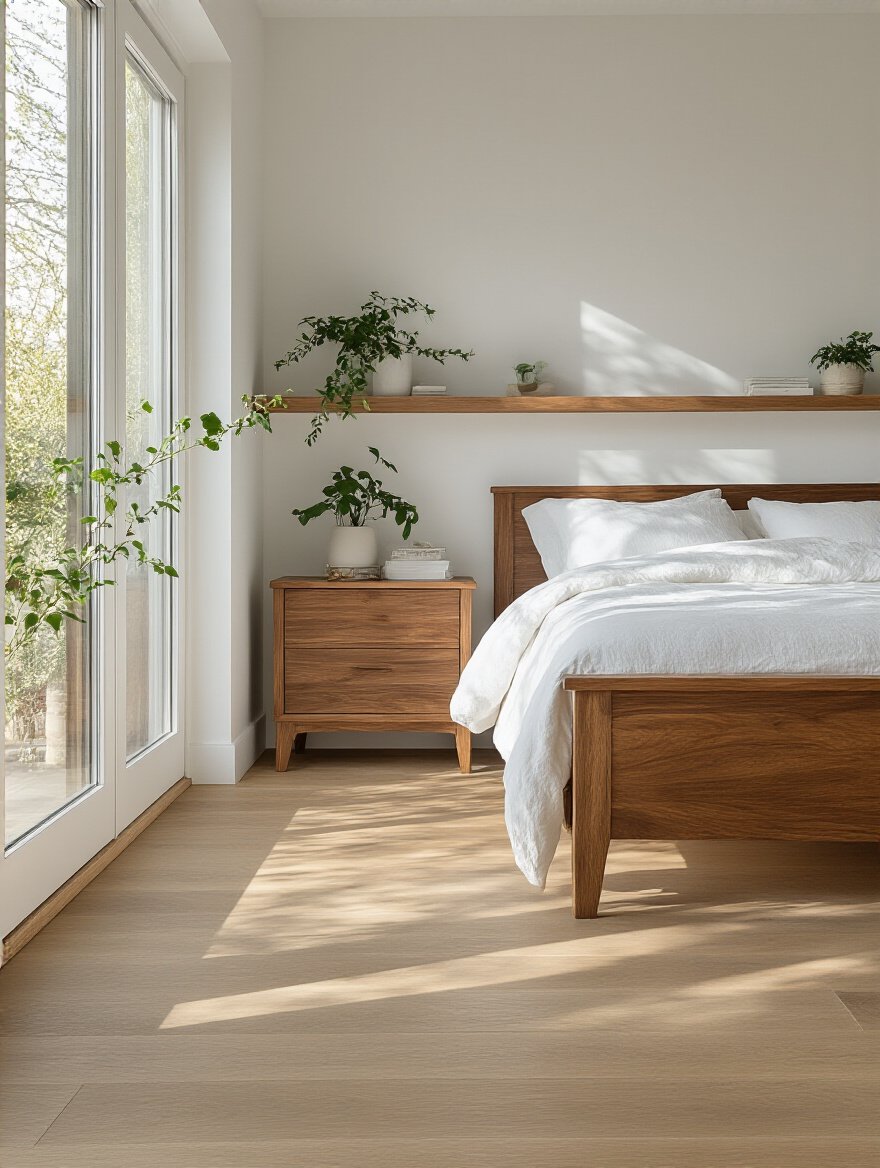
You don’t need a lot. A simple light oak bench at the foot of the bed, a pair of walnut nightstands, or even just a set of wooden picture frames can be enough. In a recent project, we used a beautiful, reclaimed wood floating shelf above the dresser. It was the only wood element in the room, but it was enough to add that perfect touch of warmth and rustic character, making the whole space feel more welcoming and balanced. The key is to let the wood be the star and keep the shapes of the furniture simple and clean.
From earthy accents, let’s move to something a bit more graphic and sophisticated.
16. Display Minimalist Black-and-White Artwork for Sophistication
Nothing says “curated” and “chic” quite like well-chosen black-and-white art in a white room. The high contrast of black against a white wall creates a powerful graphic punch that acts as a fantastic focal point. It adds a level of sophistication and intentionality without introducing the visual distraction of multiple colors. It keeps the space feeling calm and orderly, but with a confident, artistic edge.
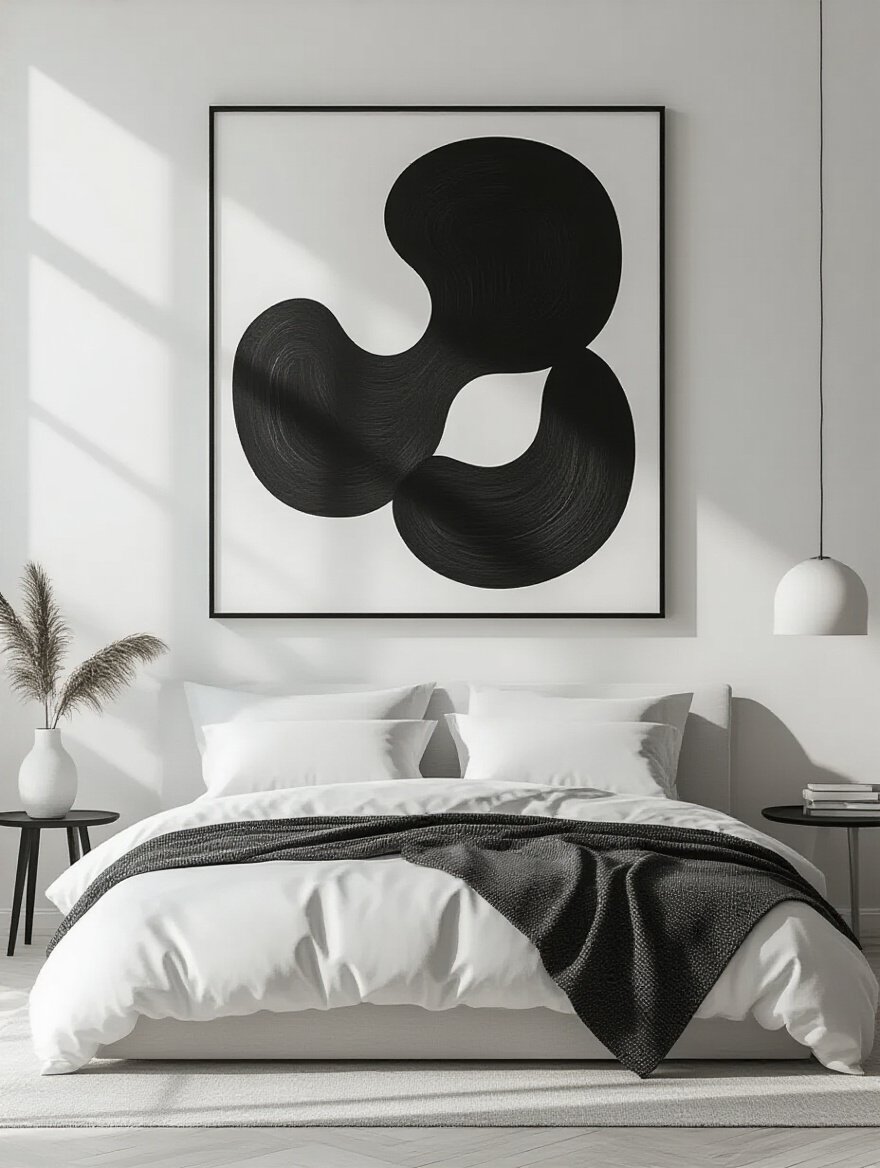
My favorite application is a single, large-scale piece of abstract art or photography hung above the bed. It makes a bold statement and anchors the entire wall. Alternatively, a gallery wall of smaller black-and-white photos or line drawings in simple black or natural wood frames can look amazing. The BS to avoid is a cluttered, haphazard arrangement. The secret to a great gallery wall is planning. Lay all the frames out on the floor first to get the spacing just right before you even think about putting a nail in the wall.
For those who want a hint of color, there’s a way to do it without losing the tranquility.
17. Incorporate a Single Muted Pastel for Gentle Serenity
This is the advanced move. If a purely neutral room isn’t for you, introducing a single muted pastel can be beautiful. The key here is twofold: “single” and “muted.” We’re talking about a dusty sage green, a pale sky blue, or a barely-there blush. You want a color that whispers, not shouts. And you want to commit to just one. As soon as you add a second or third pastel, the room can start to look more like a nursery.
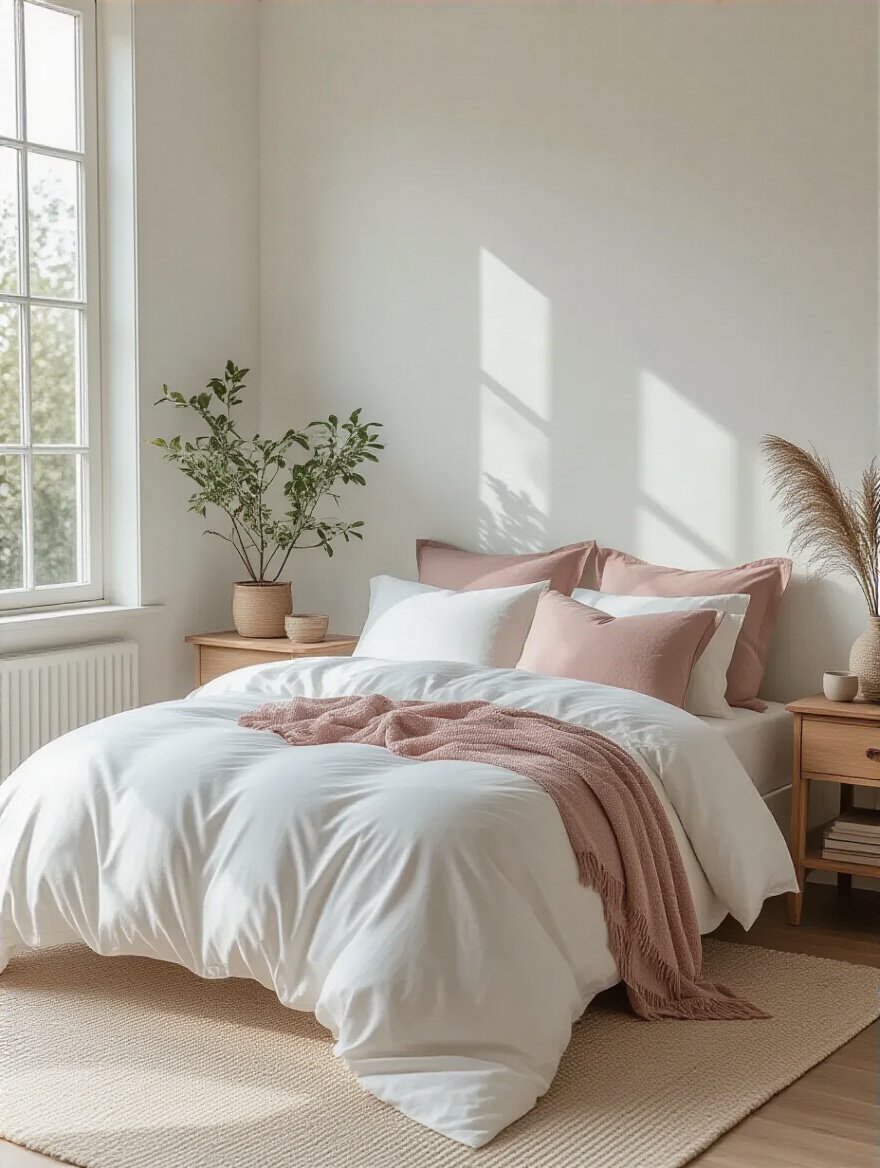
Use this single color in a significant way to make it feel intentional. This could be the duvet cover, a pair of velvet curtains, or an upholstered armchair. In one project, we used a beautiful, pale sage green linen duvet and matching shams against an all-white backdrop. It was just enough color to give the room a serene, spa-like personality while still feeling overwhelmingly calm and light. It’s a masterful touch that shows restraint and confidence.
Lighting & Flow: Enhancing the White Aesthetic
We’ve built our beautiful room, but now we have to make sure it functions perfectly from morning to night. Lighting is everything in a white space. It sets the mood, enhances the textures we’ve worked so hard to layer in, and ensures the room feels inviting, not clinical. And maintaining flow is all about keeping the systems of organization working.
18. Maximize Natural Light with Unobstructed Windows
This might sound obvious, but you’d be surprised how many people block their own light. They’ll put a tall dresser or the headboard of their bed right in front of a window, cutting off a huge percentage of natural light before it even has a chance to enter the room. Your number one job is to create a clear path for light. Arrange your furniture to leave your windows as open and unobstructed as possible.
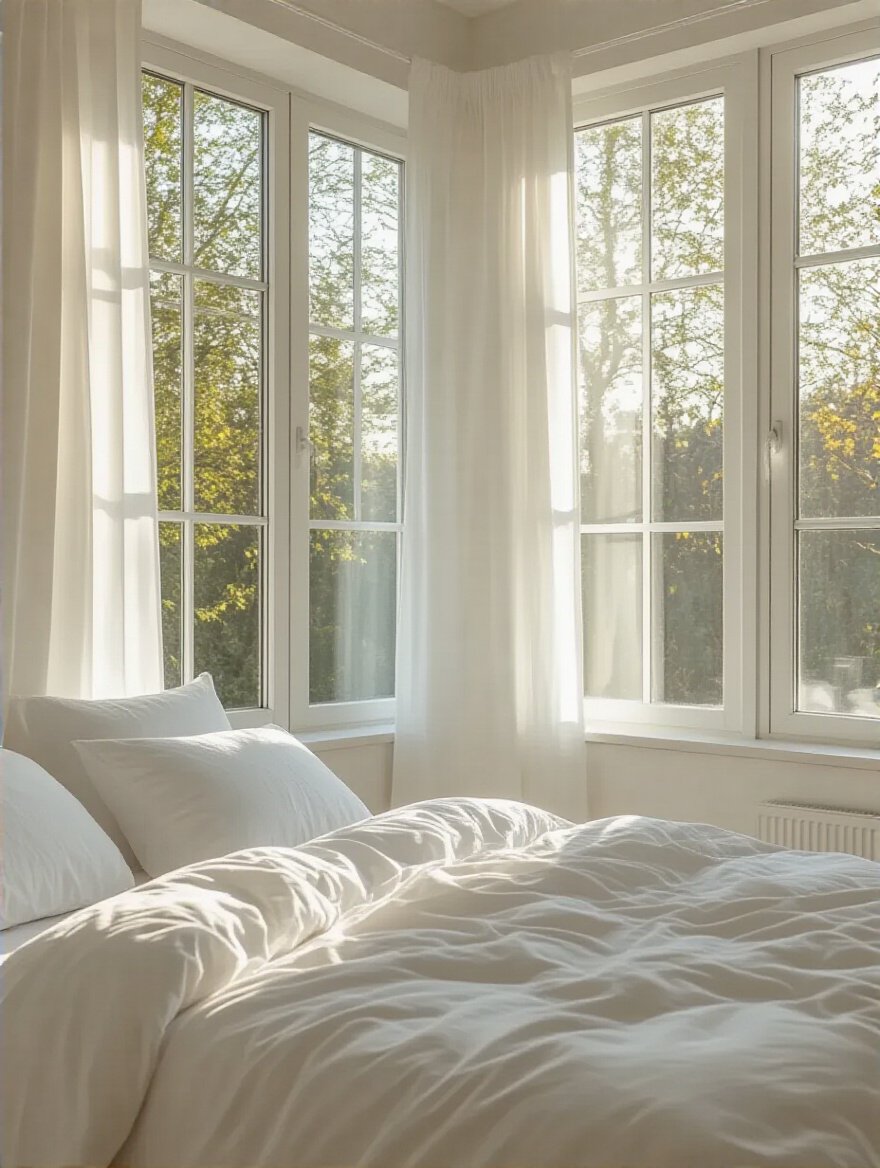
And this goes for the windows themselves. Keep them clean! It’s a boring chore, but a layer of dust and grime on the glass can cut down on light transmission significantly. This, combined with sheer curtains that you can pull completely clear of the window, ensures you are getting every last drop of that beautiful, free, mood-boosting daylight.
Once the light is in, we can use a little magic to multiply it.
19. Strategically Place Mirrors to Amplify Light and Space
Mirrors are your secret weapon in a white room. They are basically light-bouncers. The absolute best place to put a large mirror is on the wall directly opposite your main window. It will capture the light and the view and reflect them back into the room, effectively creating the illusion of a second window. It’s an age-old trick that dramatically brightens a space and makes it feel infinitely larger and more open.
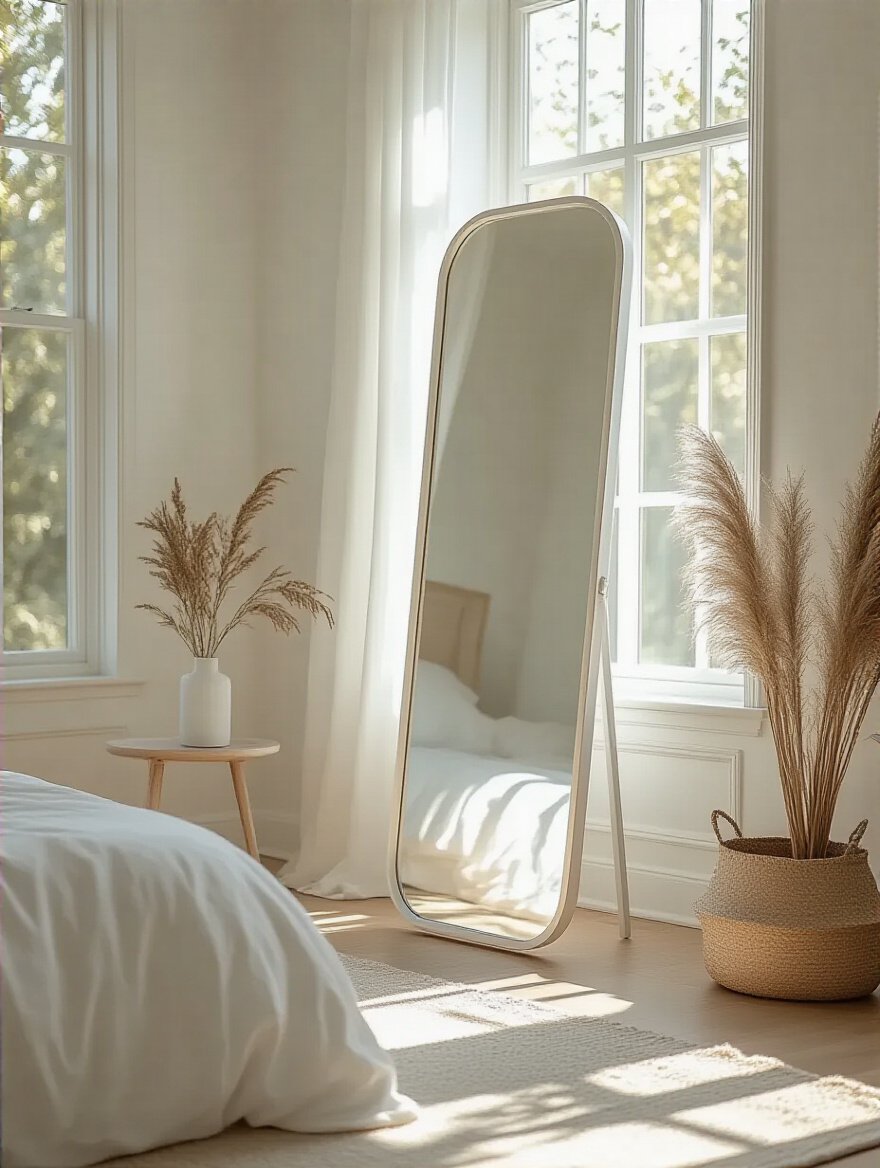
But don’t just hang a mirror anywhere. Think about what it’s going to reflect. A mirror reflecting a beautiful window view is great. A mirror reflecting a pile of clutter or a boring blank wall is not. Use them intentionally to multiply the good stuff. A full-length leaner mirror in a corner can add depth, while a large round mirror over a dresser can serve as a beautiful, reflective focal point. It’s one of the easiest and most impactful additions you can make.
Now let’s talk about what happens when the sun goes down.
20. Install Dimmable Layered Lighting for Flexible Moods
This is the single most important element for setting the mood, and it is absolutely non-negotiable in a white bedroom. One single, bright overhead light is a recipe for disaster. It will create harsh glare on all your white surfaces and make the room feel like an interrogation chamber. You need layers of light, and every single one of them needs to be on a dimmer. This gives you total control over the atmosphere.
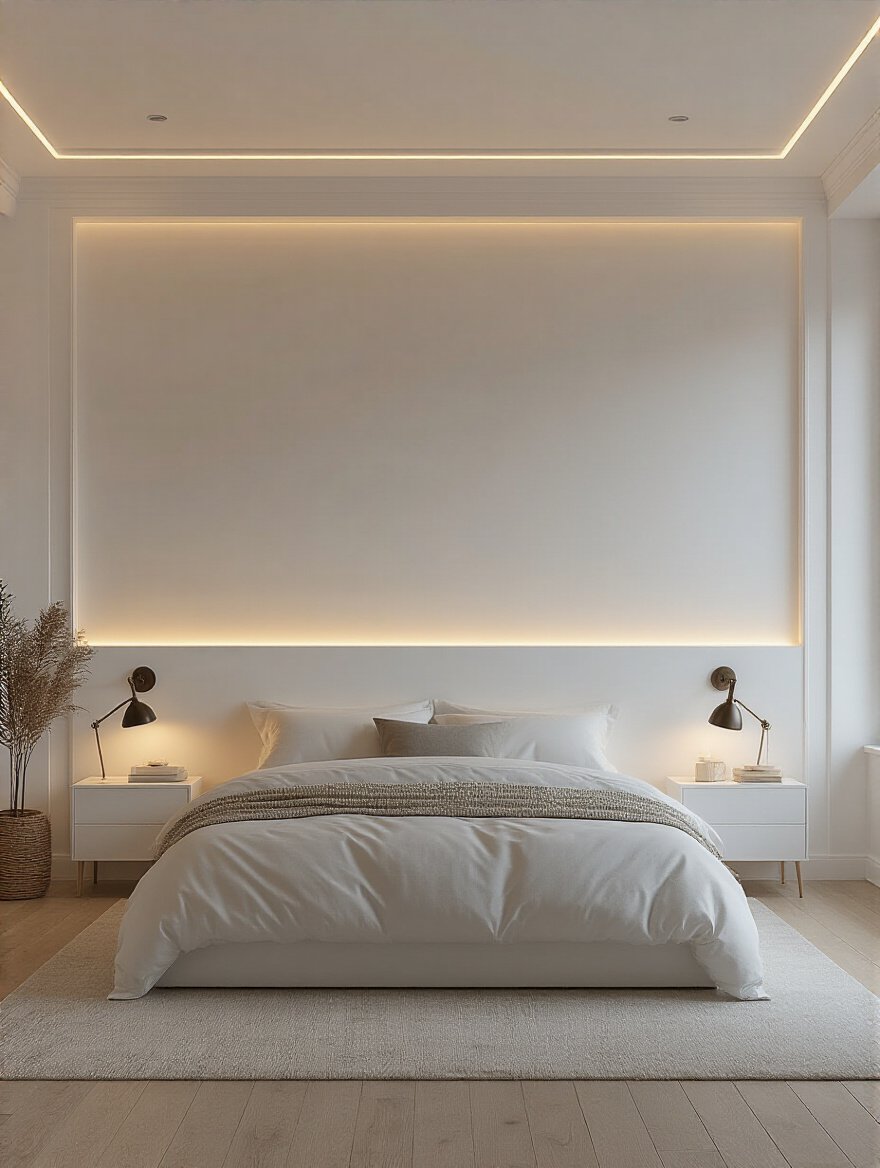
You need at least three layers:
- Ambient Light: The overall illumination from a central fixture or recessed lights.
- Task Light: Focused light for activities, like reading lamps or sconces by the bed.
- Accent Light: Soft, atmospheric light, like a small lamp on a dresser or a light that highlights a piece of art.
Being able to dim each of these layers independently allows you to transition from bright and functional for getting ready in the morning to a soft, warm, relaxing glow in the evening. A shortcut to a high-end feel is using “warm dim” LED bulbs—they get warmer in color temperature as you dim them down, perfectly mimicking the cozy glow of an old-school incandescent bulb.
Let’s focus on one specific lighting technique that adds major drama.
21. Utilize Uplighting to Emphasize Architectural Features
Uplighting is a sophisticated trick designers use to make a room feel taller and more grand. It’s exactly what it sounds like: positioning a light source low and aiming it upwards. This technique washes a wall or ceiling in a soft, indirect glow that eliminates shadows and draws the eye up. In a white room, this effect is magnified, as the light bounces gently off the pale surfaces.
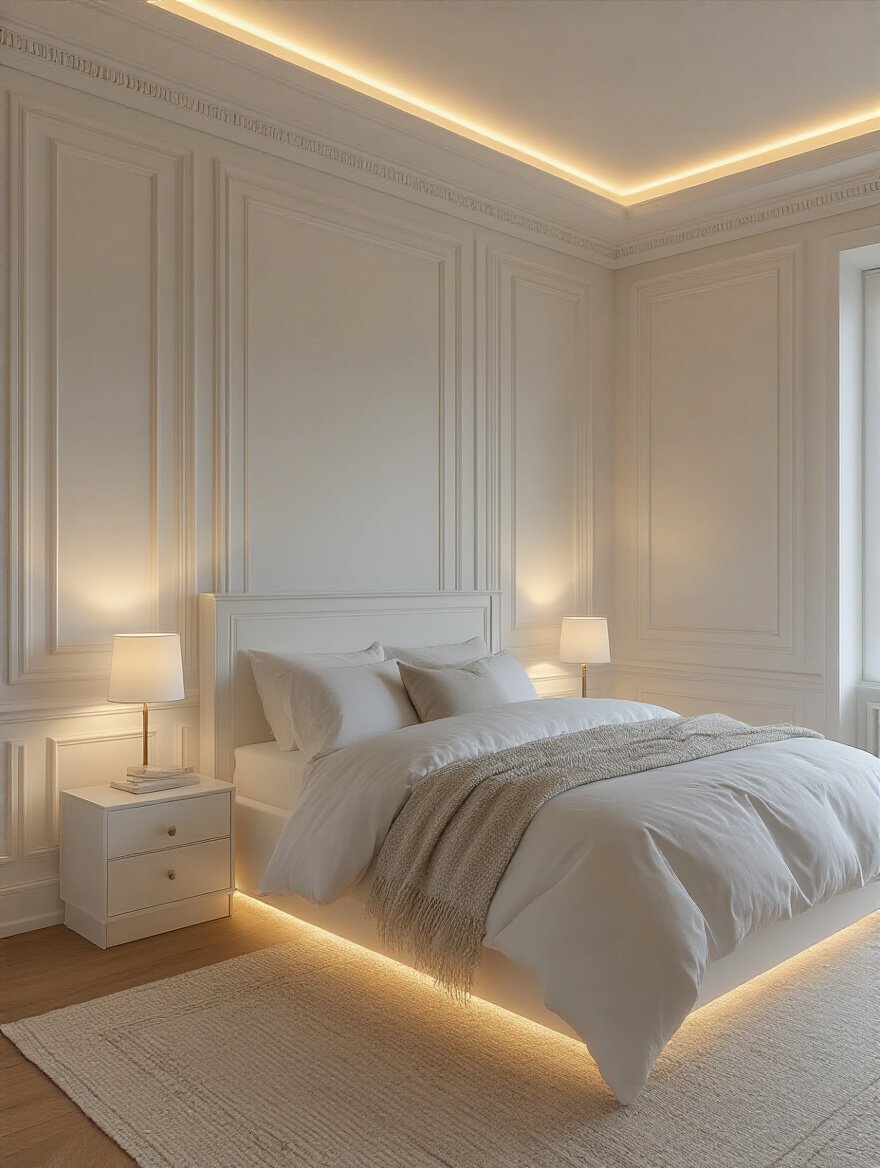
This is especially effective if you have interesting architectural details like a pitched ceiling, exposed beams, or even just some nice crown molding. You can use discreet can lights in the floor or place a simple uplight fixture behind a plant or a chair. This adds a beautiful layer of ambient light that feels very luxurious and custom, creating a tranquil atmosphere without any visible, glaring bulbs.
Personal Touches & Maintenance: Elevating Your White Retreat
The room is built, layered, and lit. The final stage is about making it truly yours and, just as importantly, keeping it that way. These final touches infuse the space with your story and ensure that the serene system you’ve created is easy to maintain.
22. Choose Fragrant White Flowers for an Inviting Scent
A truly luxurious space engages all the senses, not just sight. Placing a small vase of fresh, fragrant white flowers like gardenias, freesias, or tuberoses on your nightstand is a simple but incredibly powerful touch. The subtle, natural scent adds an invisible layer of freshness and calm that instantly makes the room feel more special and inviting.
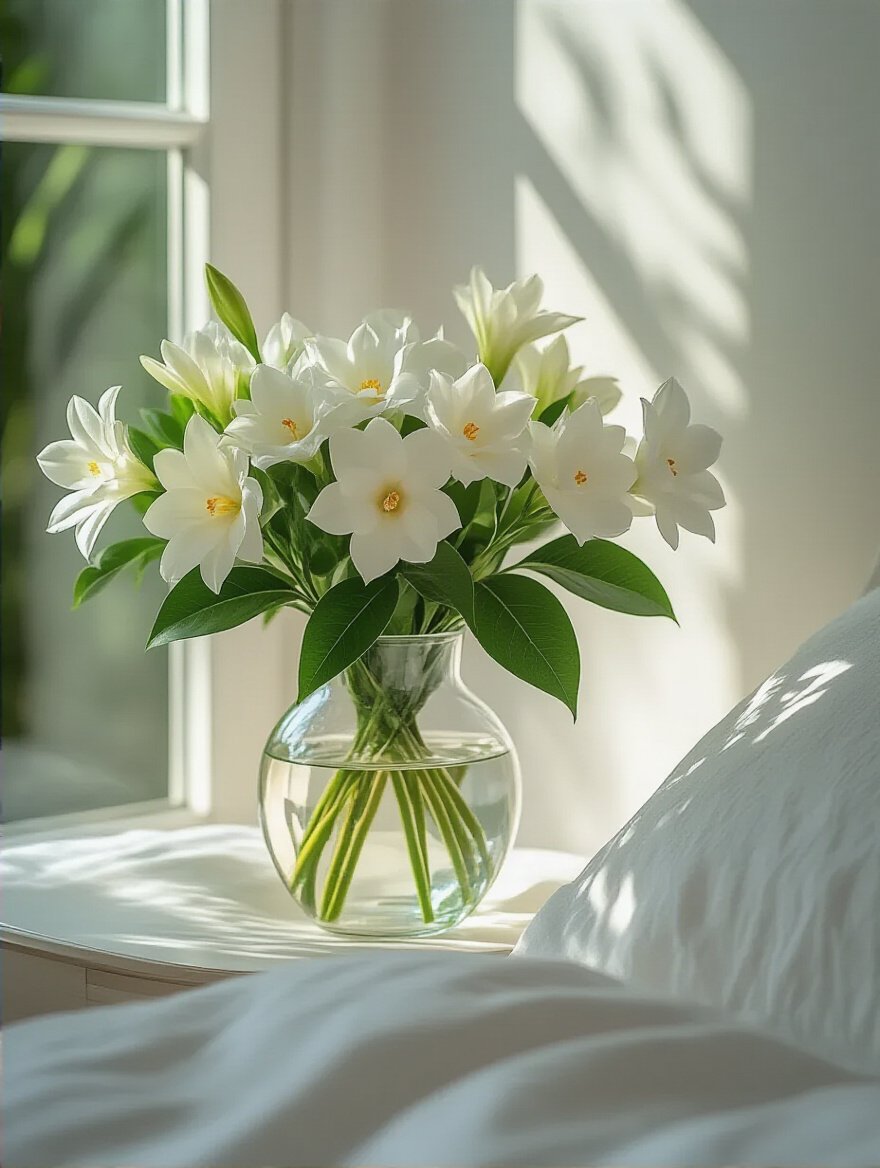
This is a much more elegant solution than a plug-in air freshener, which can be overpowering and smell artificial. The visual of the fresh white blossoms also reinforces your design scheme, adding another living, organic element to the space. It’s a small, beautiful ritual that elevates the everyday experience of being in your room.
Next, let’s make sure our beautiful space stays looking this way.
23. Organize with Discreet White Storage Solutions to Maintain Serenity
We talked about built-ins, but even the smaller organizational pieces matter. The enemy of a serene white bedroom is surface clutter. To combat this, you need smart, discreet storage for the little things. This means things like simple white lacquer boxes on a dresser to hold jewelry, woven white baskets tucked onto a shelf for extra throws, or a streamlined white tray on a nightstand to corral a book, a glass of water, and your phone.

The key is that the storage container itself should blend in. A brightly colored box screams “Look at me, I’m hiding stuff!” A white box on a white dresser just quietly does its job. I’m a huge fan of using drawer dividers inside your nightstand and dresser. Just because the clutter is behind a closed door doesn’t mean it isn’t causing you low-grade stress. Creating a clear, organized system inside your storage is the final step to true organizational peace.
Finally, let’s make the space deeply personal without creating chaos.
24. Create a White Photo Gallery Wall for Personal Expression
A white room is the perfect backdrop for a gallery wall because it lets the photos themselves be the focus. To keep it from looking messy, you need a system. The easiest way to create a cohesive, high-end look is to make all the frames the same color—white, light natural wood, or a thin black or metallic frame all work beautifully.
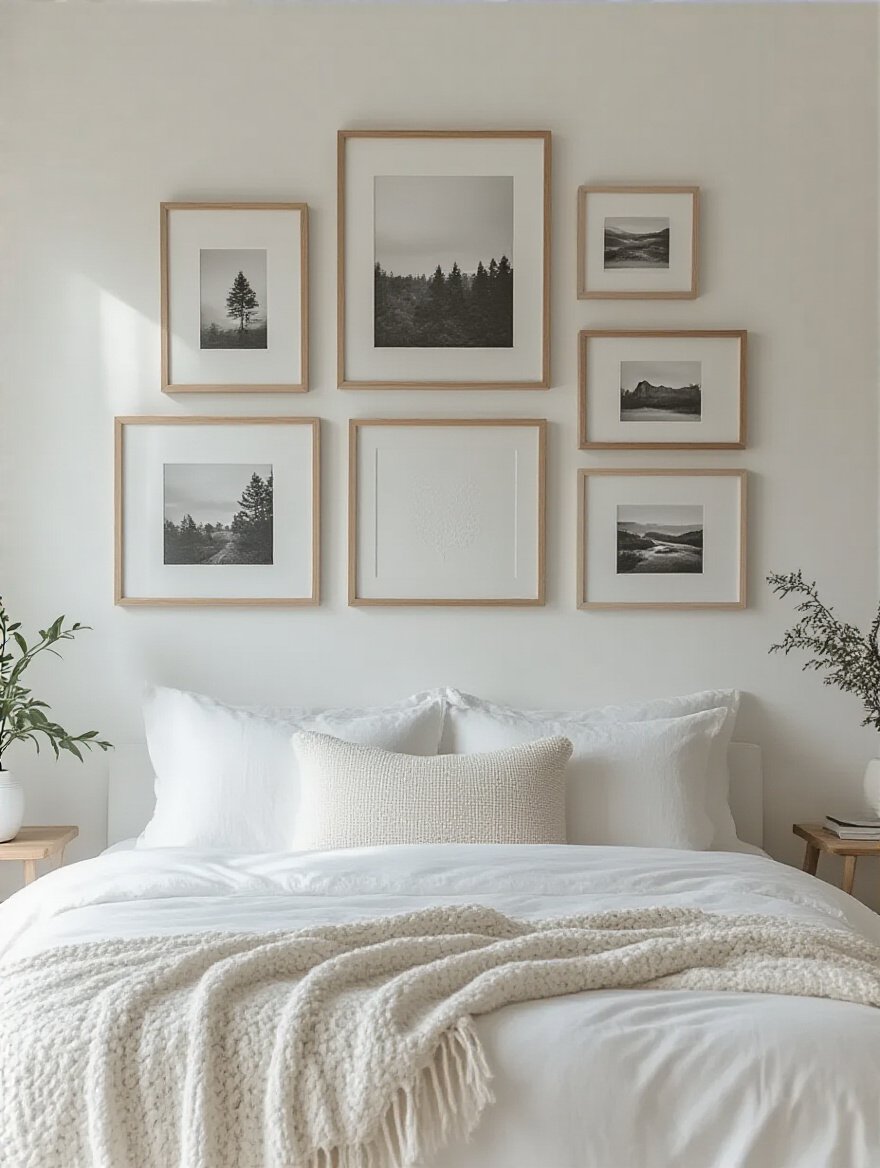
For an even more cohesive look, print all your photos in black and white or sepia. This removes the visual noise of competing colors and unifies the collection, no matter what the subject matter is. Plan your layout on the floor first, then use the paper template trick: cut paper to the size of your frames and tape them to the wall to perfect your arrangement before making any holes. And a final pro-tip: Command Strips are your best friend. They let you create and rearrange your gallery wall with zero commitment or wall damage.
Your Dream Sanctuary, Systematized
So, there you have it. A white bedroom isn’t a shortcut to easy design; it’s an exercise in discipline and artistry. But when you get the system right, the payoff is huge. You’re not just creating a pretty room; you’re designing an environment that actively works to calm your mind, reduce stress, and promote restful sleep.
By starting with a thoughtful foundation, layering in rich textures, adding intentional warmth, and mastering the art of light, you build a space that’s both a functional machine for relaxation and a beautiful reflection of you. It’s a sanctuary that feels both expansive and cozy, both minimalist and rich. You’ve now got the blueprint. Stop thinking of it as decorating and start thinking of it as building your own personal retreat.
